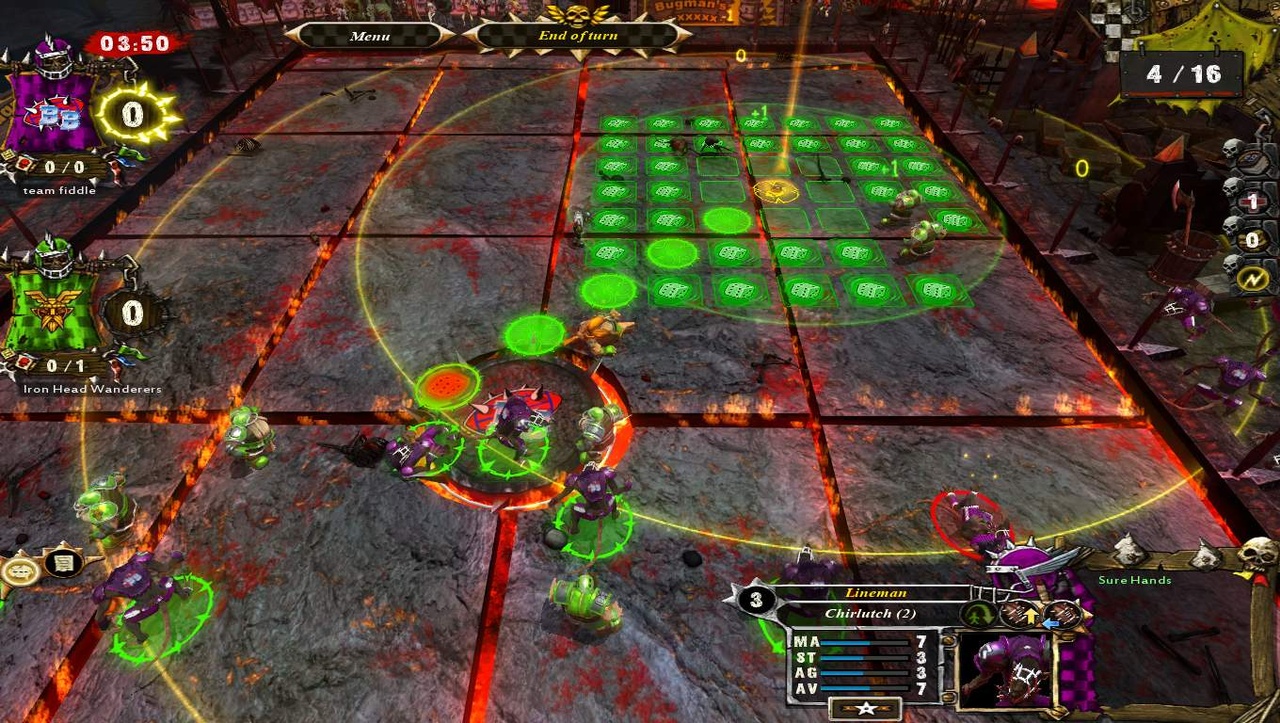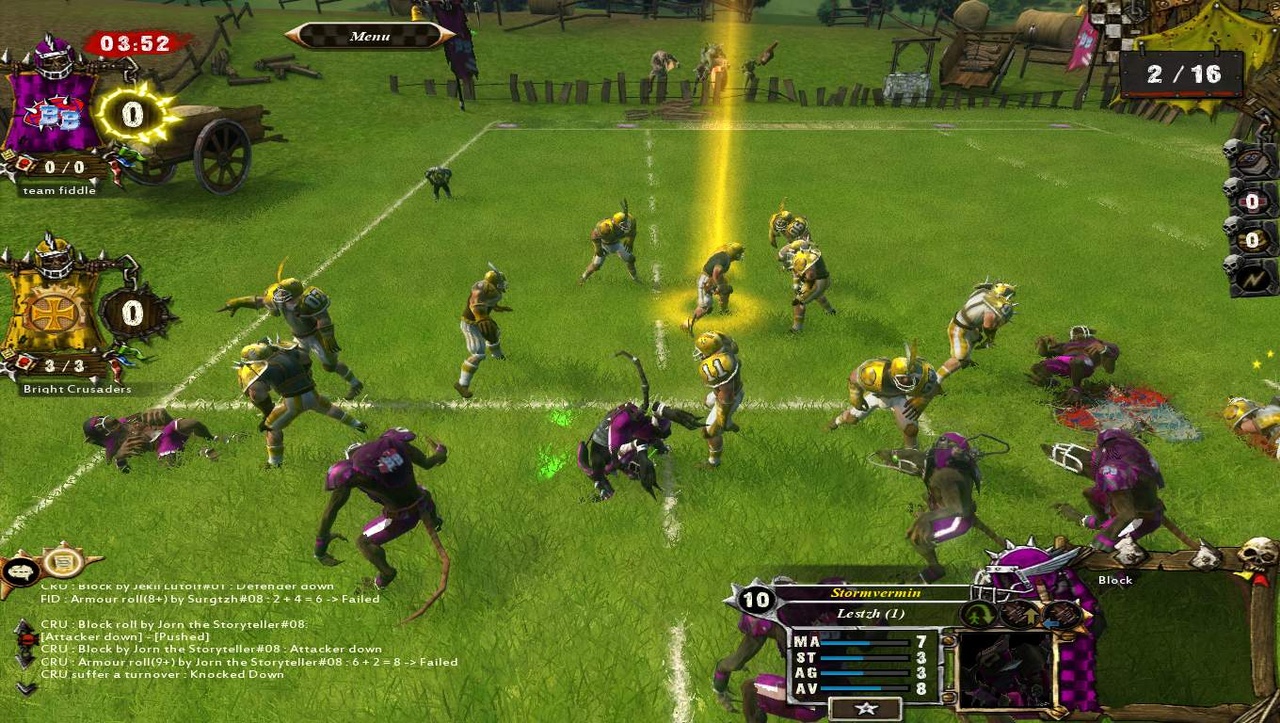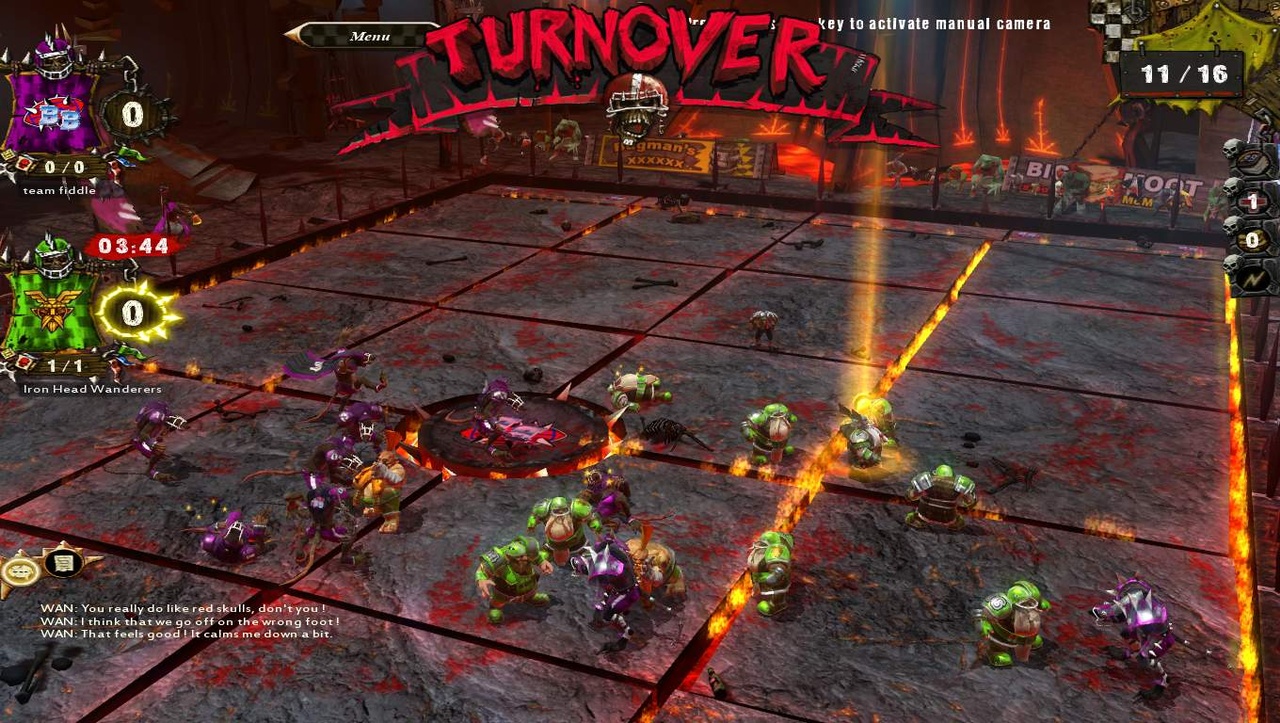Have you ever thought that American football could use even more primal energy and a bit of fantasy violence? Have you ever thought, "This sport is fine, but what it really needs is a couple of rat ogres clawing at each other?" If so, good news: Blood Bowl is for you. This adaptation of the Warhammer-themed board game pits your team against another and encourages players to digitally pound each other into a pulp (oh, and perhaps even score a few touchdowns as well). It's fun and addictive because the board game is fun and addictive, so expect to spend many an hour glued to your monitor, cheering and cursing. However, an unfriendly interface, problematic AI, and a few other issues tackle Blood Bowl just short of the end zone.
If you've never heard of the Blood Bowl board game, the idea of turn-based football within the Warhammer universe may sound a bit bizarre. Nevertheless, the game is surprisingly compelling--maybe because the raucous violence of Warhammer and the testosterone-fueled swagger of the signature American sport make such compatible bedfellows. In any case, you choose a team from a variety of Warhammer races--dwarf, skaven, wood elf, and so on--and go up against the AI or another player to prove your dominance. If you're an American football fan, you will need to make some mental adjustments before you can wrap your head around the terms and rules. What constitutes a turnover in your head isn't a Blood Bowl turnover (here, it means that your turn is over, not that you have relinquished ball possession); there are no downs, field goals, or two-point conversions; and touchdowns are worth a single point. If you're a newcomer, don't expect the inadequate tutorials to be any help--just play a bunch of matches until you get used to the intricacies of dice rolls, how cheerleaders affect gameplay, and all sorts of other small but important details.
There are a number of ways to play, both online and off, though the classic turn-based rules provide the best experience. The Campaign mode is the most enjoyable of the offline modes: you guide your team through a series of matches and level up your players, which in turn lets you choose special abilities for them. Early play sticks to the essentials. You get limited time to perform your turn, during which you maneuver your players about the field in individual turns of their own. The basic flow is similar to American football and starts with a kickoff, at which point the receiving team attempts to score a touchdown while the defenders try to gain possession, or at least hold the opposition off until the half. Individual players can knock each other down, push each other back on the grid, and cause injuries, all while you try to run and pass the ball down the field.

Even in the early hours of a campaign or a competition, Blood Bowl is exciting. Dice rolls occur almost every time two players interact, making even the smallest acts, like running past a defender or tackling the ball carrier, tense moments. The gong that resonates dramatically when you relinquish your turn during a risky play will start to make your stomach drop, but pulling off a dicey move may cause you to cheer, or at least breathe a sigh of relief. As your characters level up, the tension continues to mount, and players will benefit from their improved skills and attributes. With the right skills, you can pick up a teammate and throw him down the field, strip the ball from the carrier, or receive dodge bonuses. The more elaborate the possibilities become, the more engaging the matches are--and the more obvious the differences between each playable race become. Leveling up players is a slow process, but it provides a distinct sense of progression that adds to the "just-one-more-game" compulsion.
This addictive, nerve-wracking gameplay is what makes the board game such a cult hit and, in turn, what makes matches in this adaptation so much fun. But when you look at Blood Bowl as a video game, it's less impressive. The menus are disorganized and obtuse. Simple actions such as progressing to the next screen, distributing funds, and choosing formations aren't player-friendly, either because it's unclear that clicking a button will pull down a menu, the screen is too cluttered, or because buttons are poorly labeled. The poor tutorial and jumbled interface deliver a poor first impression, and even once you get used to them, they feel like dead weight designed to keep out newcomers. If you're new to Blood Bowl, you'll be able to get past these issues, but it'll take a bit of time to get accustomed
Going online doesn't ease the annoyance--it only exacerbates it. There is a public league and a large number of private leagues to join, but working your way through the unfriendly interface is a chore. Even then, you can't play a friend online in a simple one-off game unless you are a member of the same league and dig into the challenge menu to find him or her. You can use the LAN menu to direct-connect to a buddy via IP address, but not having an easy option for online play outside of leagues is all sorts of silly. LAN play and hotseat play for two players at a single computer are terrific features, but they can't make up for an important online feature gone missing.
The leagues, however, still offer thrilling competitive play. The public league is your best bet for competition, and it uses standard Blood Bowl 5.0 rules. The basic rules remain the same as in the single-player game as you move your way up the ranks, and as you would expect, matches against human players are challenging. You'll face competition from all over the world, and many of your competitors have a firm grasp of the rules, and of the strengths and weaknesses of each race. In the single-player game, the AI is all over the place. Your CPU opponent may clump players together and give your ball carrier a chance to run through an opening unscathed. Other times, dice rolls feel clearly stacked in the AI's favor, as if to make up for its deficiencies. League matches present no such issues, so expect your rival to take advantage of every weakness and every opening. Expect challengers to use a greater variety of formations than the AI, and to deftly position each player on the field. And accordingly, expect anxiety every time a player moves and joy every time a gamble pays off. The risk-to-reward ratio in Blood Bowl is deftly handled and makes online play in particular both demanding and exciting.
If you want to explore the game outside of the classic turn-based play, you can mess around with other customizable rules and options, the most intriguing of which, at least initially, is real-time play. Sadly, what sounds like a great idea is in reality a chaotic, unsatisfying mess. You can set various AI behaviors for your players, but matches feel out of control, and it becomes quickly obvious that attributes that make sense on a turn-by-turn basis don't translate well to a real-time environment. For example, the movement attribute is an important aspect of turn-based play that effects how far a player can travel in a single turn. In real-time play, you'd think this would translate to speed, but there is little difference in speed between players you'd think should be quick and those that shouldn't. The resulting disruptions to race balances, and the overall sense of disorder, keep real-time rules from being anything more than a quick diversion, and you'll probably be done with real-time play after one or two muddled matches.

Blood Bowl's production elements are not technically impressive, which makes the lengthy loading times leading up to every match all but inexplicable. However, the game does offer an authentic Warhammer experience, thanks to colorful representations of the board game miniatures and some cool-looking stadiums. The animations are simple, but some of them are still charming, such as the acrobatics the wood elves pull off when dodging a tackle. You can personalize your team if you want even more authenticity, using various uniform colors and emblems, but the options are limited, and in some cases, they don't look right. Team logos don't fit properly on the orc uniforms, and some races have more creation options (faces, warpaint, beards, etc.) than others, which is disappointing considering the important role customization plays in the board game. The sound design also gets the job done, but with a major drawback: the commentary is awful. The actors' voices are annoying and they deliver the same cringe-worthy quips over and over again. There was a huge opportunity here to explore the violent wit that characterizes the Warhammer brand, but it was left unexplored.
Blood Bowl's drawbacks are such that the board game faithful will grin and bear them simply because the core turn-based strategizing is so good. Each match is a tense, tactical standoff, and the game will keep you up past your bedtime because it's so hard to pull yourself away. However, the aspects that weren't culled from the board game--the interface, the commentary, the bizarre real-time matches--feel messy and improvised. Nevertheless, Blood Bowl is good fun, even if it doesn't deliver on its full potential.
